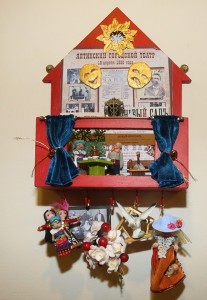 I had no idea how to start making Chekhov until I saw the rather strange wooden thing at a bootfair. I’m not sure what it was originally, perhaps something to hang in a hall to keep keys and letters in. As soon as I saw it I realised it was perfect for showing “Uncle Vanya”, for which I couldn’t find a dangler. What scene could I manage in such a tiny space? The stage directions for Act 1, scene 1 turned out to be made to measure. I even found a miniature samovar which arrived from Siberia, and flushed with that success changed the required guitar on the bench to a balalaika.
I had no idea how to start making Chekhov until I saw the rather strange wooden thing at a bootfair. I’m not sure what it was originally, perhaps something to hang in a hall to keep keys and letters in. As soon as I saw it I realised it was perfect for showing “Uncle Vanya”, for which I couldn’t find a dangler. What scene could I manage in such a tiny space? The stage directions for Act 1, scene 1 turned out to be made to measure. I even found a miniature samovar which arrived from Siberia, and flushed with that success changed the required guitar on the bench to a balalaika.
The gun on the wall represents Chekhov’s influential remark, known as Chekhov’s gun: “If there is a rifle on the wall in the first Act, it must be fired in the Second”. The playbills are copies of early notices for his plays, with pictures of Chekhov himself and the actress Olga Knipper, who became his wife. The caduceus is there because he was a doctor.
Another famous saying of his was: “Medicine is my wife, literature my mistress, and when I get tired of one, I go and spent a night with the other”. The danglers are for his other most famous plays, “The Cherry Orchard”, “The Seagull”, “Three Sisters”; and “The Lady with the Little Dog” represents his short stories. Again I was lucky to find a miniature of the exact breed of dog Chekhov mentions. ‘Convicts on Sakholin Island’ is a nod to his (self-funded) trip to visit this barbarous place. Chekhov was a quiet revolutionary. He brought to public notice the conditions on Sakholin Island. He changed theatre and the short story for ever. He loved trees.
If I had another life I would like to work in the theatre, maybe doing nothing but putting on Chekhov’s plays.